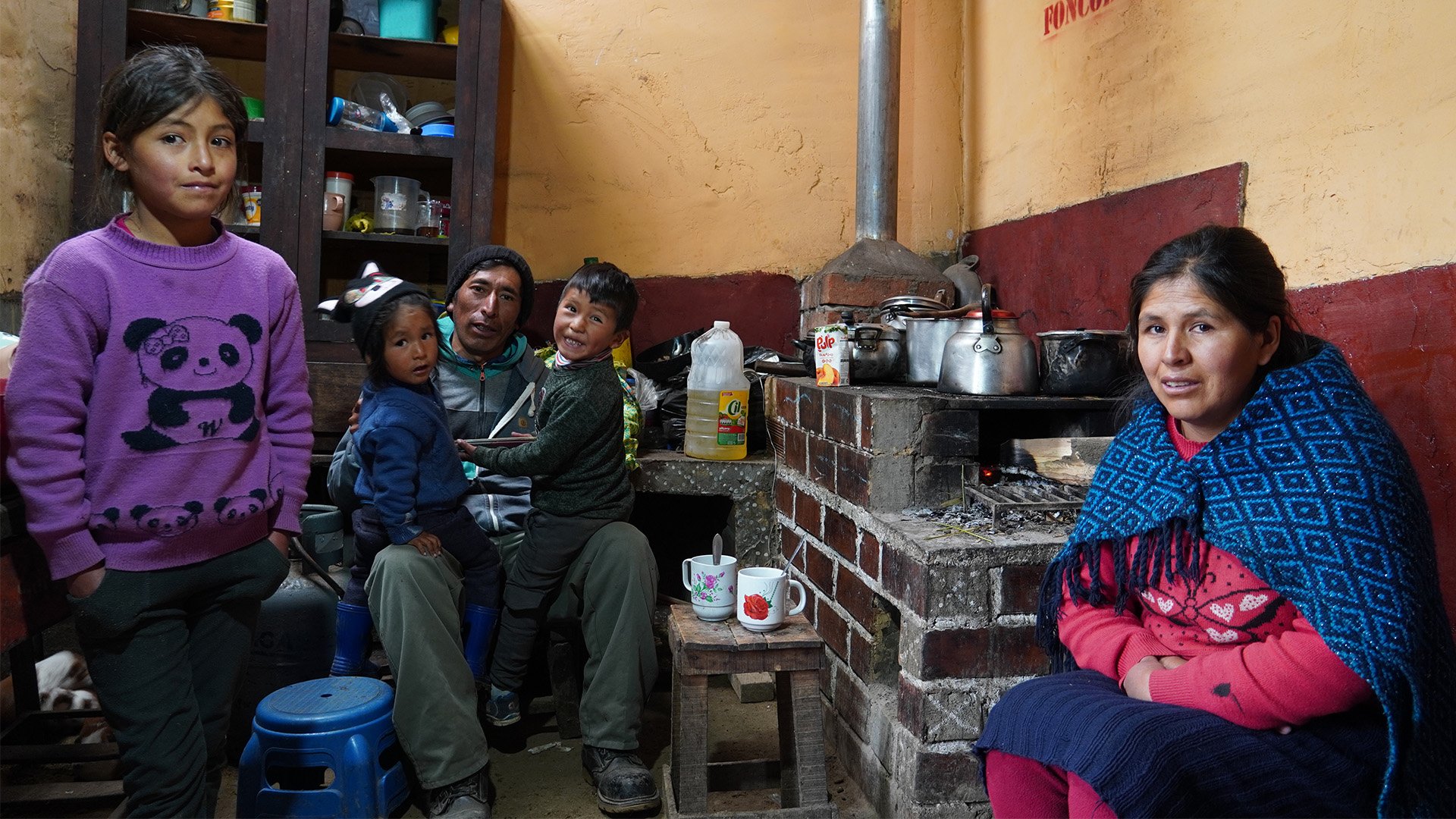‘Children are bearing the brunt of the crisis.’
Changing climate, changing lives: This occasional series of reports from the front lines of climate change explores how extreme weather already affects millions of people in different settings around the globe, looking at both the real-world impacts and possible ways forward.
Small pools of water are all that’s left of the lagoon that once stretched out across these sponge-like wetlands in Peru’s central Andes. Less water means less pasture for flocks of alpacas to graze, and less moisture for the bog, or bofedal, that supplies water for farms and towns lower down the mountains.
In the Apata district, and much of the central Junín region, the mountain is drying out.
The parched margins of Lake Pomacocha, at 4,479 metres, are also a concern for alpaca herders, as drought conditions take hold, exacerbated by climate change, and particularly by the El Niño weather phenomenon.
Thought to have been first observed – and named – by fishermen off the coast of Peru, El Niño events are marked by above-average Pacific Ocean temperatures, which cause heavy rains in some parts of the world but drought in others like Junín, as well as in the Amazon rainforest to the east.
Junín is one of 13 regions in Peru operating under a water emergency because of the risk of shortages. Nationally, between 2019 and 2022, 674 state of emergencies for drought were declared in dozens of districts, and 36,333 hectares of land were lost to farming.
“Before, they were full of water; now, the lagoons have dried up,” Catalina Cerrón, a 54-year-old Alpaca herder from the Apata village of Chicche, told The New Humanitarian as a pair of Andean flamingos wandered into one of the sparse pools nearby. “This drought is harsh. There was water; now, it is dry and there is nothing for the pastures.”

William Campbell, country director in Peru for Save the Children International, said Andean communities are being affected by “droughts, frosts, and hail, every year.”
“Now, with the El Niño, these events are coming… not only more often, but with more intensity,” he said, adding: “Children are bearing the brunt of the crisis.”
Chronic malnutrition in children aged under five rose for the first time in 12 years, to 11.7% in 2022, according to Peru’s statistics institute. Furthermore, anaemia affected 42.4% of children in the same age bracket in Peru in 2022, particularly hitting the Andes and Amazon regions.
Peru is one of the world’s main producers of avocados, mangoes, blueberries, table grapes, asparagus, and peppers – the industry generated $5.7 billion in the first eight months of 2023 despite being disrupted by the unseasonably hot temperatures caused by El Niño.
But the export-focused industry hasn’t helped alleviate Peruvians’ hunger: Last year, half the population — some 16.6 million people — were food insecure, the highest rate in South America, and twice as many as before the pandemic.
Global inflation and Peru’s overdependence on imported food forced tens of thousands of Peruvians to turn to soup kitchens last year, particularly in the capital Lima and its outskirts.
Junín is one of the world’s highest regions and one of Peru’s most fertile, located in the breadbasket of the country for staples like potatoes and maize. But its high altitude also makes it more vulnerable to water scarcity.
The looming drought is expected to affect nearly 850,000 people in this highland region, according to Peru’s National Centre for Estimation, Prevention and Reduction of Disaster Risk, CENEPRED, and some 100,000 farmers and about 1,160 square kilometres (116,000 hectares) of crops will be impacted as well.
“When they are affected by drought, the losses in crops and livestock mean a total loss of assets, because there is no way to recover quickly,” said Luis Romero, who advises Save the Children on climate change, risk, and disaster management in Peru.
‘We have to risk a lot’
Peru has 28 different types of climates, making it more vulnerable to climate shocks, flooding, landslides, and droughts. The country has lost half of its glacier surface in the last 60 years because of global warming.
The Internal Displacement Monitoring Centre found that disasters – most linked to climate change, particularly floods – had forced almost 700,000 people to move from their homes between 2008 and 2022.
The Peruvian government has said it will allocate $1.1 billion to mitigate the impact of El Niño, for work such as clearing rivers and flood prevention, but little has been allocated to deal with the drought and, according to a November Oxfam report, no additional resources were granted to districts with states of water emergency.
A few hundred metres downhill from Lake Pomacocha, a farming community prepared land for a potato crop, using a tradition that dates back to pre-Columbian times.
Working in pairs, the men use a chaquitaclla, or foot plough, to turn the soil, while women part the sods and replant the potato seeds that have been scattered in the moist ground.
The farmers rapidly carve out the lines of dark brown soil on the hillside, before taking shelter under tarpaulin during a rain shower, chewing coca with lime, and swigging from a bottle of alcoholic spirit called aguardiente.
They are accustomed to dramatic shifts in the weather; at this altitude, it can feel like there are four seasons in one day. But global warming has heightened unpredictability, David Figueroa, a 54-year-old farmer, told The New Humanitarian.
“In the old days, the rain came early – it was lovely,” Figueroa said. “We planned the dates when we sowed all our crops. Now when we sow, it’s a gamble… we have to risk a lot and we can’t put all our trust in the harvest.”
“The country and the cities are fed by family agriculture — not by agri-exports — and the droughts affect with greater force the small or so-called family agriculture that is mainly located in the highlands.”
Angela Dionisio from the Centre for the Study and the Promotion of Andean Amazonian Development
He is prepared for dwindling yields and low prices for their crops, and said this year the harvest will mostly be for the “kitchen table”.
Junín is one of the main regions where potatoes are grown – usually at altitudes of between 2,500 and 4,500 metres above sea level. Peru is Latin America’s leading producer of potatoes, growing more than 6 million tonnes last year, according to its agriculture ministry.
Angela Dionisio, from the Centre for the Study and the Promotion of Andean Amazonian Development (Desco), said the state has a vested interest in keeping people in the countryside and should be helping to build reservoirs to conserve Peru’s water supply.
“The country and the cities are fed by family agriculture — not by agri-exports — and the droughts affect with greater force the small or so-called family agriculture that is mainly located in the highlands,” said Dionisio.
While Peru has made progress in designing public policies for disaster management, the political instability of recent years – with six presidents in as many years — has weakened the state’s reach and effectiveness. “The state has forgotten the rural areas,” said Dionisio.
‘We make do with what we have’
High prices for imported fertilisers, partly attributed to the conflict in Ukraine, means that subsistence farming families across the country are struggling. Government mismanagement was blamed for not planting potatoes and maize on more than 30,000 hectares at the beginning of the season in August 2022.
The effects of this failure are being felt in 2023. For subsistence farmers, failing crops and underfed livestock are part of an ongoing crisis. Inflation has come down from its peak earlier this year, but that has brought little relief.
Senio Hinostroza, 37, a highland farmer in San José de Apata, Junín, is raising three children — aged nine, four and two — with one hectare of land on which he grows potatoes and other tubers. He also has some 20 head of alpaca and sheep that graze on common land.
“The bigger [potatoes] we sell to buy rice, sugar, and noodles to vary our diet, but when we don’t have them, or there are only small ones, they don’t even buy from you,” Hinostroza said. “And if you sell, you sell for less; you can no longer make a profit.”

Hinostroza works on other farms — earning less than $10 a day, or 35 Peruvian soles — to put food on the table.
The uncertainty makes him and his wife Estelita Quinto anxious. Quinto stirred a lunchtime stew of potatoes and a little mutton over a wood-fuelled stove in a low, dank kitchen as sunlight peeped through a tiny window, providing the only light.
“We have to make do with what we have,” she said. “If there is no meat, I put more potatoes [in the soup].”
She worries if there will be enough to eat, and that the unpredictable weather will cause her children to get ill more frequently.
Farming way of life under threat
As the young increasingly move away to seek opportunities elsewhere, the fabric of rural society and the future of farming in these remote areas is fraying.
“[We are seeing] families composed of two elderly people who depend on other people for their livelihood,” Romero said. “Many young people [have left] because working in agriculture and livestock farming is no longer profitable due to climate change, so they choose to go to the city.”
In the city, they lose their ties to the land, and their families.
“The sense of community is broken,” Romero added.
Farming is a way of life for 60-year-old Eduvina Veliz, who has raised her own family in Nueva Esperanza, a farming village down in the valley beneath Lake Pomacocha.
“Everyone [now] would rather be sitting in an office,” she joked.
Along with her husband, Veliz tries to make ends meet with their three dairy cows. But earning around 1.5 soles ($0.40) per litre of milk brings in daily earnings of a little more than 50 soles ($13).
As pasture becomes scarcer and more difficult to maintain, the income barely covers the costs.
Veliz keeps around 150 guinea pigs, which provide a ready source of protein and some income when times are hard. Even so, she believes she will be the last in a long line of farmers in her family, and points to the lack of state investment in agriculture.
Source : The New Humanitarian











